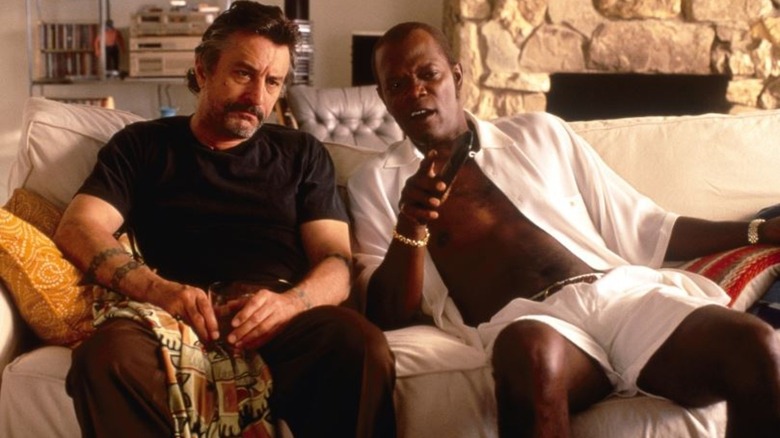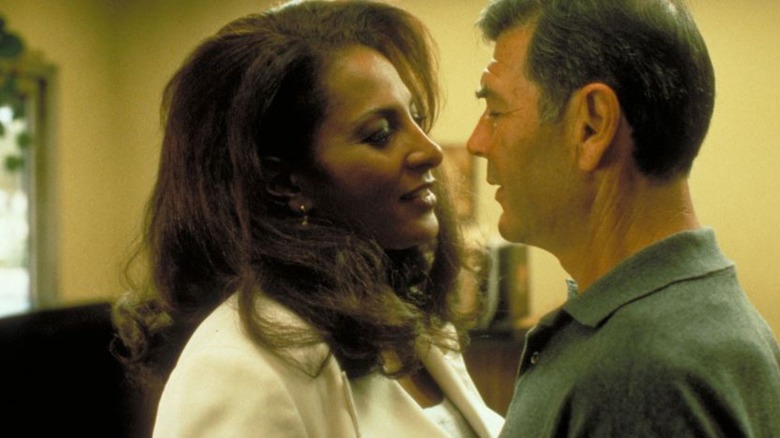Jackie Brown's Modern-Day Setting Was A Challenge For Cinematographer Guillermo Navarro
Quentin Tarantino followed up his second directorial effort and cult classic "Pulp Fiction" with the 1997 crime film "Jackie Brown." An homage to the blaxploitation movies of the '70s, the film stars Pam Grier — an icon from those blaxploitation flicks — as the titular character, a Los Angeles flight attendant who gets entangled in a cat and mouse chase between the feds and Ordell Robbie (Samuel L. Jackson), a gunrunner for whom she smuggles drugs and money.
Though some consider "Jackie Brown" to be one of Tarantino's most underrated movies, it is an anomaly in his filmography. Not only is "Jackie Brown" the sole Tarantino movie adapted from a previous work (it's based on Elmore Leonard's novel "Rum Punch"), it also lacks that certain oomph that has made the director both one of the most popular and controversial filmmakers of the modern era.
That was by design, as Tarantino knew his usual style wouldn't work for "Jackie Brown." He told American Cinematographer: "I wanted 'Jackie Brown' to have richness and depth, but I wanted it to look more real. My other films do look very real, but at the same time there's a splashy-movie quality to them." Looking to create a more modern-day setting, the director didn't recruit Andrzej Sekula, the cinematographer who worked on his first two films. Instead, he turned to Guillermo Navarro, who had recently worked on "From Dusk Till Dawn," "Long Kiss Good Night," and "Spawn."
Filming in airports and malls was real, but not visually interesting
One quality of "Jackie Brown" that does align with the traditional Quentin Tarantino film is that it is dialogue-driven. This posed the biggest roadblock for Guillermo Navarro considering the film's realistic and modern-day setting. Navarro told American Cinematographer:
"The fact that this was a contemporary story had a lot to do with how I approached the style. Anything seen in everyday life is absent of the 'magic' of style due to one's daily relationship to it. Interpretation is an ingredient one can sculpt with when addressing the future or the past, but not when dealing with a contemporary story that has strong doses of realism. This entire film takes place at locations everyone has a visual relationship to — such as a mall and an airport. There's no interpretation that can cross the everyday vision of these places, so I had to take a very realistic approach. But being on location can be very difficult because [you're] stuck with the space. Since the story is very dialogue-driven, it became complicated to execute some of the shots [in a visually interesting way]."
I understand Navarro's point. I've seen movies in which airport and mall scenes were the most exciting scenes in the films. "Jingle All the Way," starring Arnold Schwarzenegger immediately comes to mind. But most of these movies were action or comedy movies that used the settings as prompts. Because Tarantino wanted to take a more realistic approach, the modern settings merely serve as backdrops for conversations and wasn't glitzed with any of eye-popping aesthetics like, say the Jack Rabbit Slim's restaurant in "Pulp Fiction," for example.
Guillermo Navarro and Quentin Tarantino focused on cool-looking faces
To help overcome this obstacle, Guillermo Navarro and Quentin Tarantino employed a variety of shooting methods, one of which Tarantino calls the Sergio Leone close-ups, which he explained as "tight close-ups in which the top of the frame ends on the actors' foreheads and the bottom of the frame ends on the bottom of their chins." He elaborated on the effectiveness of this technique. "It's a very strong choice to shoot them like that since we used actors who have cool-looking faces."
Navarro noted that the length and nature of the conversation in a given scene dictated the framing. He explained his use of the Clairmont's SwingShift lens system, which he said can be used to build dramatic tension.
"In one sequence, Jackie is in court being arraigned on charges of cocaine possession. One shot includes both the judge behind his podium and Jackie back in the gallery seats, and we brought the shot together at the moment when he is deciding her fate. We had to swing the lenses drastically, because its a very severe shot — a close-to-the-lens profile of her, and the judge way back in focus.
I admit I'm not an expert in cinematography, but I definitely can relate to Navarro's struggles. I worked as a TV news field producer, and one of my responsibilities was to find aesthetically pleasing backdrops for correspondents to go live from during the newscast. Depending on the story being covered, finding an eye-grabbing setting to complement it was not easy at all. Imagine how much harder it must be to find the right location for a feature film, and shoot around any challenges it might present.


